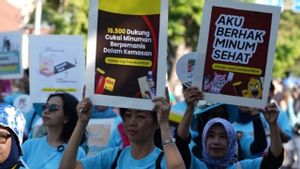JAKARTA Komika Kiky Saputri is grieving after experiencing a miscarriage due to a cyst. Not only that, Kiky also had to undergo the removal of the ovarian or egg reservoir on the left.
Kiky shared his bitter experience with his husband, Muhammad Khairi, on his personal YouTube channel, Monday (18/4/2024). The owner's full name Rizhky Nurasly Saputri said he had a miscarriage when his pregnancy entered 10 weeks. The fetus in his womb could not survive because of the cyst he was suffering from.
Even though he admitted that he had known about the cyst since last year, Kiky Saputri still could not hide his sadness. Especially after a miscarriage, the cyst that sticks to the ovaries turns out to be getting bigger even though it has taken a series. This must be done so that the cyst does not grow and spread to other organs of the body.
Reported by Care, the ovaries are organs similar to almonds, which are part of the women's reproductive system. Each woman has two ovaries, one on the right and one on the left side of each uterus.
The National Health Service describes two main functions of the ovarian, namely to release eggs every 28 days in the menstrual cycle and release the sexual hormone, namely estrogen and progesterone, which plays an important role in the reproductive system.
Meanwhile, ovarian cysts are bags containing fluids that develop in ovaries. These diseases are very common and usually do not cause any symptoms. Most ovarian cysts occur naturally and disappear in a few months without requiring any treatment.
Cysts are tame tumors that are often found in women at reproductive age. According to Global Cancer Incidence data, Mortality and Prevalence (Globocan) in 2018, 295,414 women were diagnosed with ovarian cysts and 4.4 percent of them were cancer-related.
In Indonesia, the incidence rate in 2018 was reported to be 13,310 women suffering from ovarian cysts and with a death rate of up to 3.8 percent or 7,842 people dying.
Citing Care, ovarian cysts are generally asymptomatic until their condition breaks, they are too large, or clog blood in the ovaries. However, large ovarian cysts can cause a number of symptoms such as experiencing pain in the hips, pain when having sex, and difficulty defecating.
"Haid is irregular and too few and too many are also a sign of the ovarian cyst," NHS quoted him as saying.
Because they do not have specific symptoms, most people with diseases only do treatment, precisely when the ovarian cyst has grown. Reported by Airlangga University's official website, as many as 70 percent of patients who come to the hospital are usually in advanced stages.
The ovarian cyst is often called the silent killer because many women are late in knowing about the cyst when they have been reached from outside or are growing. Based on Indonesia's health demographic survey, the incidence of the ovarian cyst in Indonesia reached 37.2 percent.
To find out whether there is an ovarian cyst, it can be done in several ways, among which the most common thing to do is through a Transvaginal Ultrasound (TVS) examination and a histopatological examination.
Although considered harmless and can disappear by itself, the ovarian cyst cannot be underestimated because it has the potential to bend or break, causing serious symptoms.
SEE ALSO:
In addition, in some conditions, tame ovarian cysts can potentially become malignant or ovarian cancer. Before menopause, ovarian cysts are usually not malignant. However, after menopause, tame ovarian cysts can be more at risk of becoming malignant. Ferocious ovarian cysts contain cancer cells that can cause ovarian cancer.
This is supported by the results of an analysis which states age is a major factor as a risk factor for ovarian ferocity. At premenopause age, the risk of ovarian cyst ferocity is 1:1000, so it can be said that ovarian cysts rarely develop into malignant cancer before menopause.
The English, Chinese, Japanese, Arabic, and French versions are automatically generated by the AI. So there may still be inaccuracies in translating, please always see Indonesian as our main language. (system supported by DigitalSiber.id)














